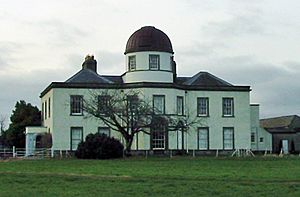Dunsink Observatory facts for kids
The Dunsink Observatory is a famous place in Ireland where people study space and stars. It was built a long time ago, in 1785, near the city of Dublin.
One of its most famous leaders was William Rowan Hamilton. He was a brilliant scientist who discovered something called quaternions. This was a new type of math! He figured it out while walking from the observatory. Every year, people do a special walk called the Hamilton Walk to remember his discovery. He also created important ideas in physics called Hamiltonian mechanics.
Over time, the city of Dublin grew closer to the observatory. This made it harder to see the stars clearly from there. The main telescope is now mostly used for public "open nights." This is when people can visit and learn about space.
Today, Dunsink Observatory is part of the Dublin Institute for Advanced Studies (DIAS). It's a busy place where scientists meet and hold conferences. It's also used for public events. People can attend talks about astronomy and astrophysics. There are also stargazing events where you can look through the Grubb telescope.
Contents
Discovering Dunsink Observatory's Past
The Dunsink Observatory was started because of a gift of £3,000. This money came from the will of Francis Andrews. He was the head of Trinity College Dublin when he passed away in 1774. The observatory was built on a small hill in a place called Dunsink. It is about 84 meters above sea level.
The Grubb Telescope: A Star Gazer's Friend
One of the most important tools at the observatory is the South Telescope. It is also known as the 12-inch Grubb telescope. This telescope uses lenses to see far-off objects. It was built by Thomas Grubb in Dublin and finished in 1868.
The main lens for this telescope was given by Sir James South in 1862. He had bought the lens 30 years earlier from a company in Paris. He had planned to use it for a very large telescope. But that project had problems and was taken apart. Luckily, the lens found a home at Dunsink!
Dublin's Own Time Zone
For many years, Dunsink Observatory helped tell the official time for Ireland. From 1880, the official time was called Dublin Mean Time. This was based on the sun's position at Dunsink. It was like how Greenwich Mean Time (GMT) was set at the Royal Observatory, Greenwich in London. In 1916, Ireland changed to use GMT, just like many other countries.
A New Chapter for the Observatory
In 1936, Trinity College Dublin stopped looking after the observatory. The land was rented out. But in 1947, a new plan brought it back to life. Éamon de Valera, who had started the DIAS in 1940, created a new section called the School of Cosmic Physics. This school was given the job of taking care of Dunsink Observatory. This helped the observatory become active in science again.
The person in charge of Dunsink Observatory was also known as the Andrews Professor of Astronomy. This was when the observatory was part of Trinity College Dublin.
Who Led Dunsink Observatory?
Many important scientists have led Dunsink Observatory over the years. They were called the Directors. Here are some of them:
| Dates | Name | What they did |
|---|---|---|
| 1783–1790 | Rev. Henry Ussher | First Director. |
| 1792–1827 | Rev. John Brinkley | Also the Royal Astronomer of Ireland. |
| 1827–1865 | Sir William Rowan Hamilton | Became Director at 21. He worked on math and physics, discovering quaternions. |
| 1865–1874 | Franz Brünnow | Had to retire due to health issues. |
| 1874–1892 | Sir Robert Stawell Ball | Later became a professor at Cambridge. |
| 1892–1897 | Arthur Alcock Rambaut | Later became an observer at Oxford. |
| 1897–1906 | Charles Jasper Joly | Passed away while in office. |
| 1906–1912 | Sir Edmund Taylor Whittaker | Later became a professor at Edinburgh. |
| 1912–1921 | Henry Crozier Keating Plummer | Later became a math professor. |
| 1921–1936 | Charles Martin | Was an Acting Director. |
| 1936–1947 | Vacant | No astronomy work was done during this time. |
| 1947–1957 | Hermann Alexander Brück | Later became the Astronomer Royal for Scotland. |
| 1958–1963 | Mervyn Archdall Ellison | Passed away while in office. |
| 1964–1992 | Patrick Arthur Wayman | Retired after many years. |
| 1994–2007 | Evert Meurs | Retired from his role. |
| 2007–2018 | Luke Drury | Retired after leading the observatory. |
| 2018–present | Peter T. Gallagher | The current head of Astronomy and Astrophysics at DIAS. |


